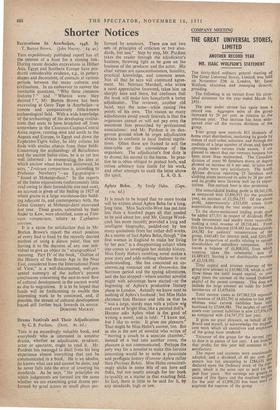Shorter Notices
THIS expeditiously published report has all the interest of a hunt for a missing link. During recent decades excavations in Hither' Asia, Egypt and Southern Europe have pro- duced considerable evidence, e.g., in pottery shapes and decoration, of contacts at various periods between the many cultures and civilisations. In an endeavour to answer the inevitable questions, "Why these common features ? " and "Whence were they derived ? ", Mr. Burton Brown has been excavating at Geoy Tepe in Azarbaijan—a remote and comparatively little-known archaeological field. With a wide knowledge of the archaeology of the developing civilisa- tions that seem to have branched off from somewhere in the Caucasus-Caspian-Central Asian region, running west and south to the Aegean and Europe, to Egypt and down the Euphrates-Tigris valley, he ably collates his finds with similar objects from those fields. Concerning the archaeology of Baluchistan and the ancient Indus cities, he is as yet less well informed ; in enumerating the sites at which ancient wheat has been discovered, he says, " Triticton cornpactum is, according to Professor Newberry "—an Egyptologist- " found at Mohenjo-daro." In the reports of the Indus excavations (unfortunately little read owing to their formidable size and cost), an account is given of the finding in 1927 of wheat grains in a large warehouse-like build- ing adjacent to, and contemporary with, the Great Granary at Mohenjo-daro excavated last year. These grains, submitted by their finder to Kew, were identified, some as Trill- cum compactum, others as. T.sphaero- coccwn.
It is a cause for satisfaction that in Mr. Burton Brown's report the exact position of every find is fixed by the recently decried method of using a datum point, thus not leaving it to the decision of any one indi- vidual to give an object its " stratigraphical " meaning. Part IV of the book, "Outline of the History of the Bronze Age in the Near East, considered from the International Point of View," is a well-documented, well-pre- sented summary of the author's present conclusions concerning the east-to-west flow of cultural development in the ancient world as due to migrations. It is to be hoped that funds will be forthcoming to enable this interesting work to be continued, and, if possible, the stream of cultural development traced still further back towards its source.
DOROTHY MACKAY.














































































 Previous page
Previous page